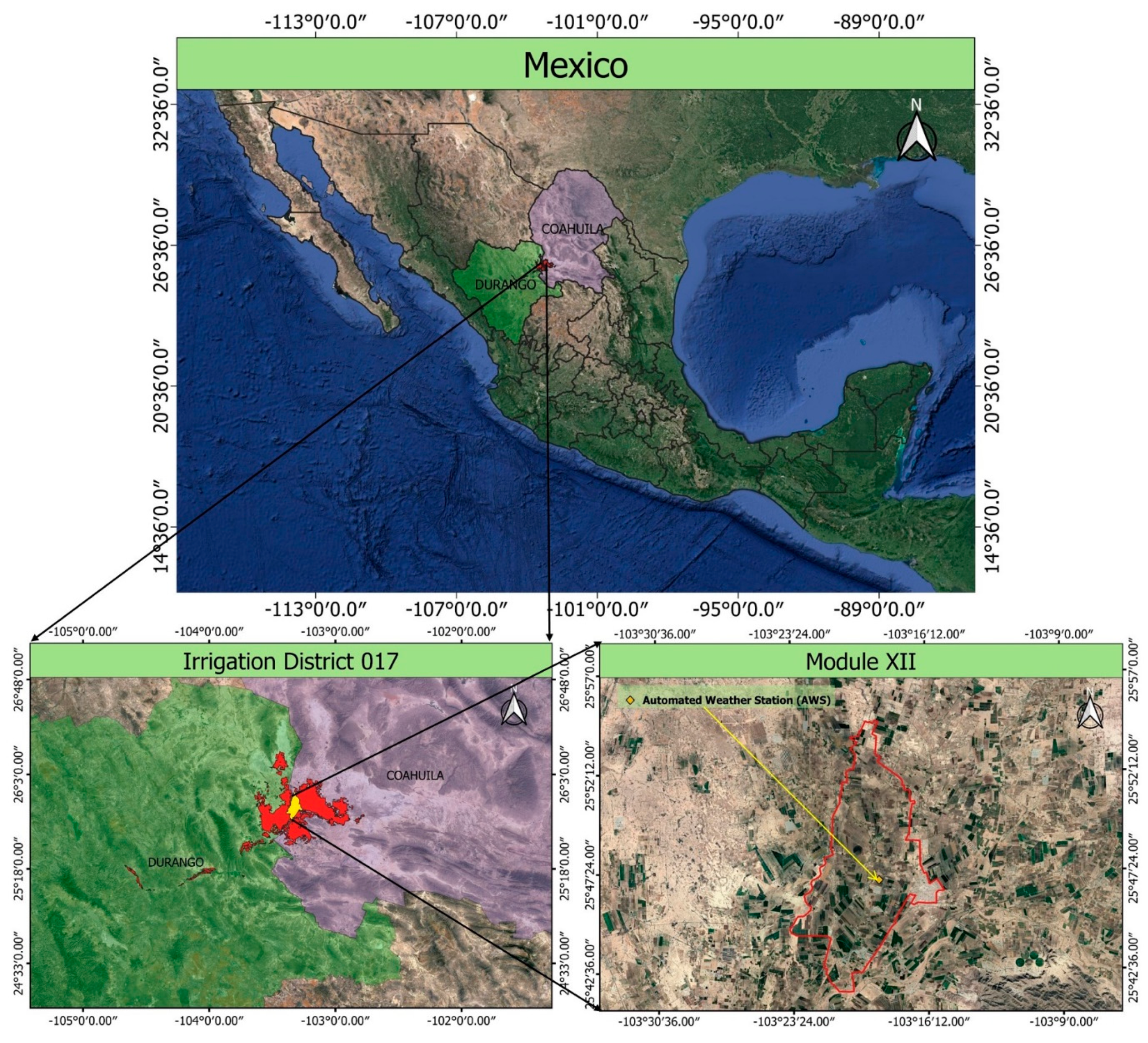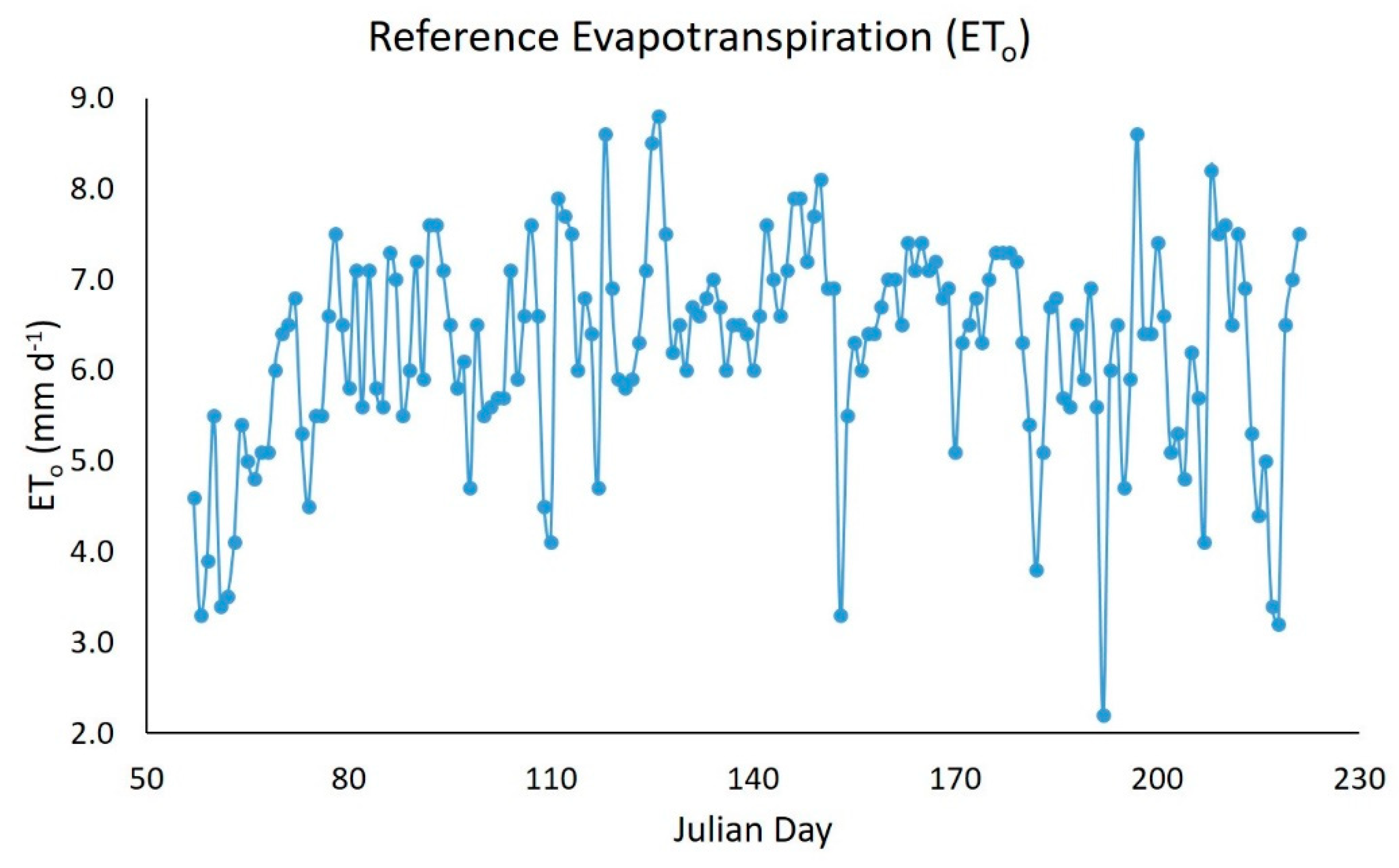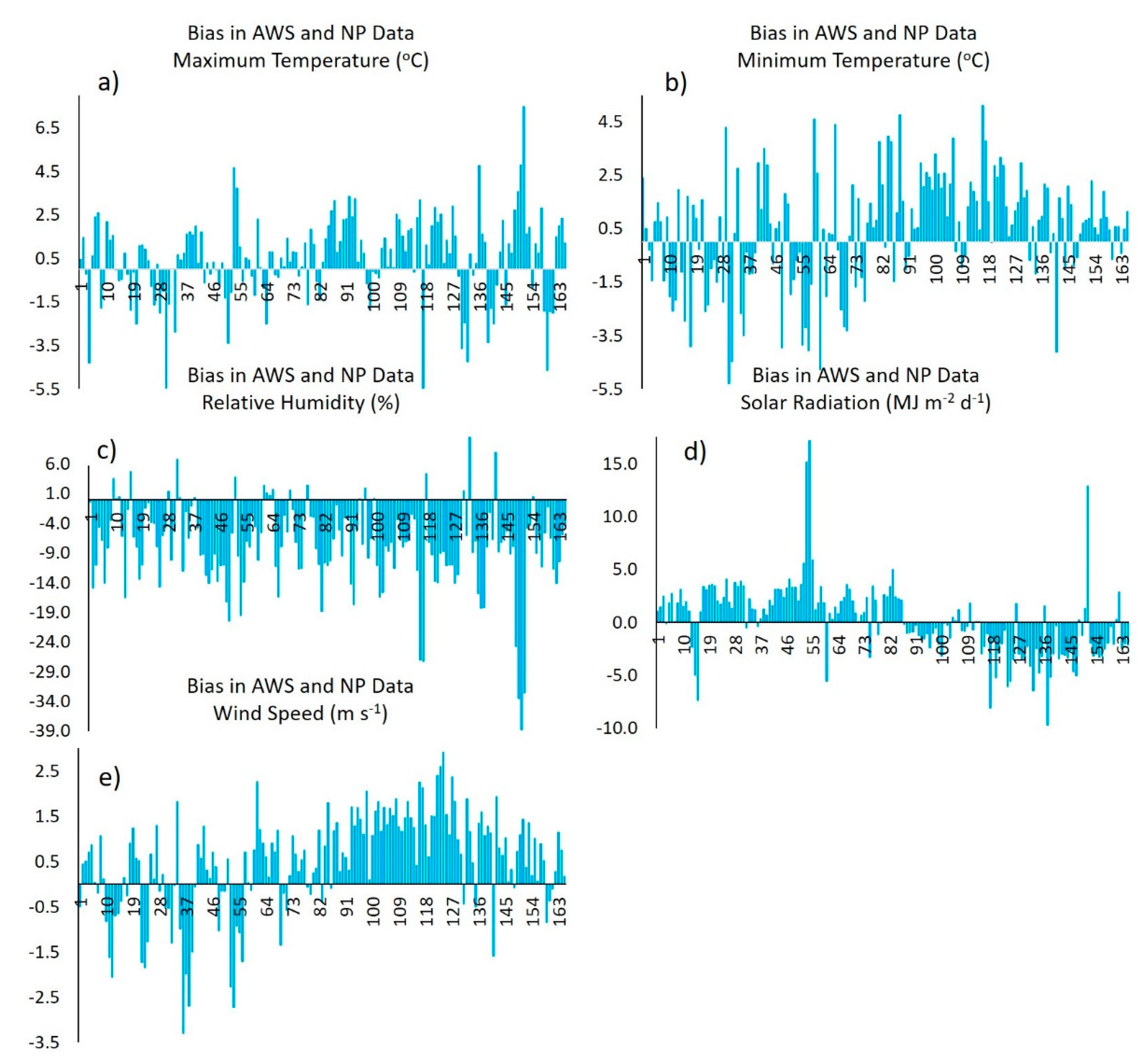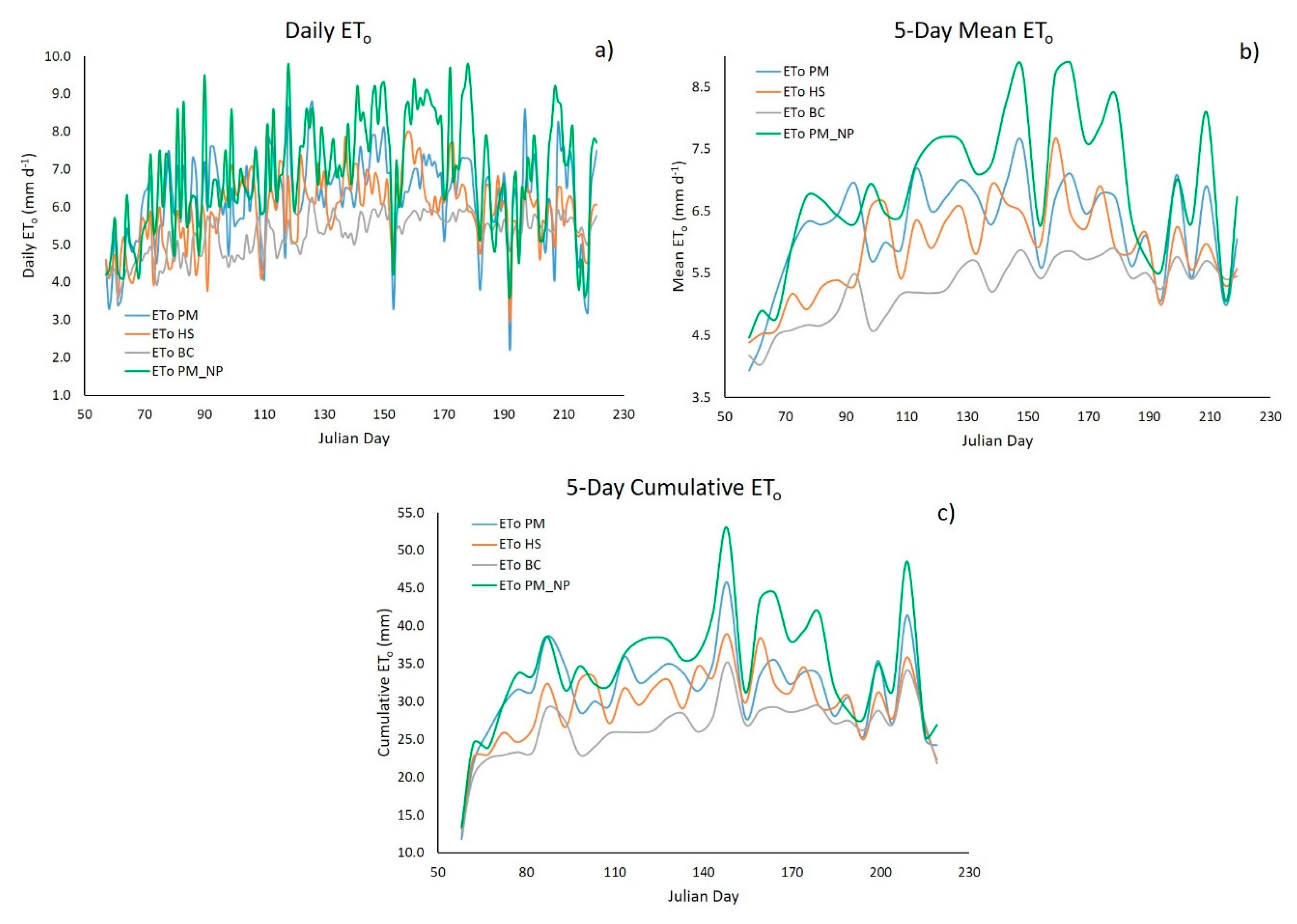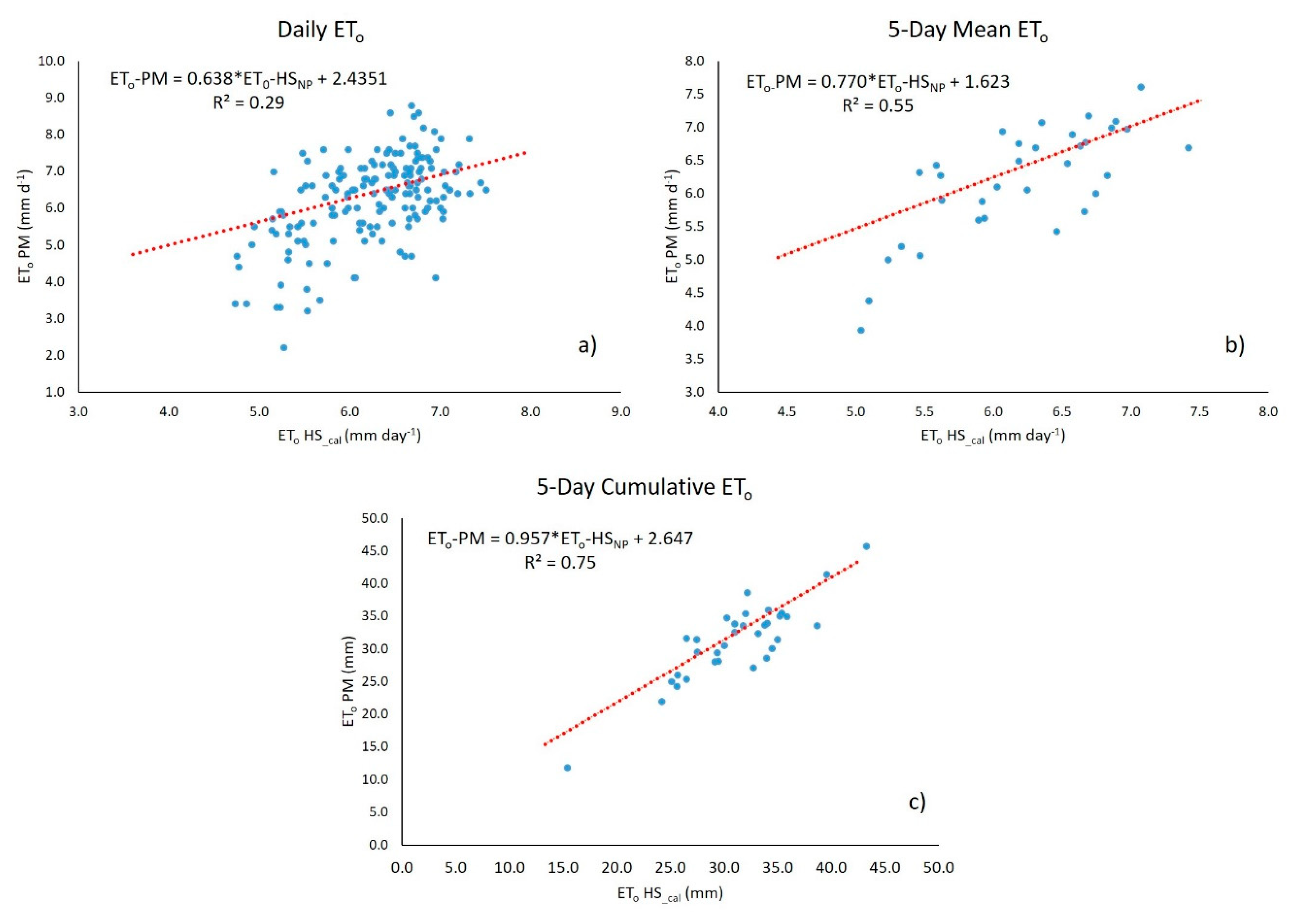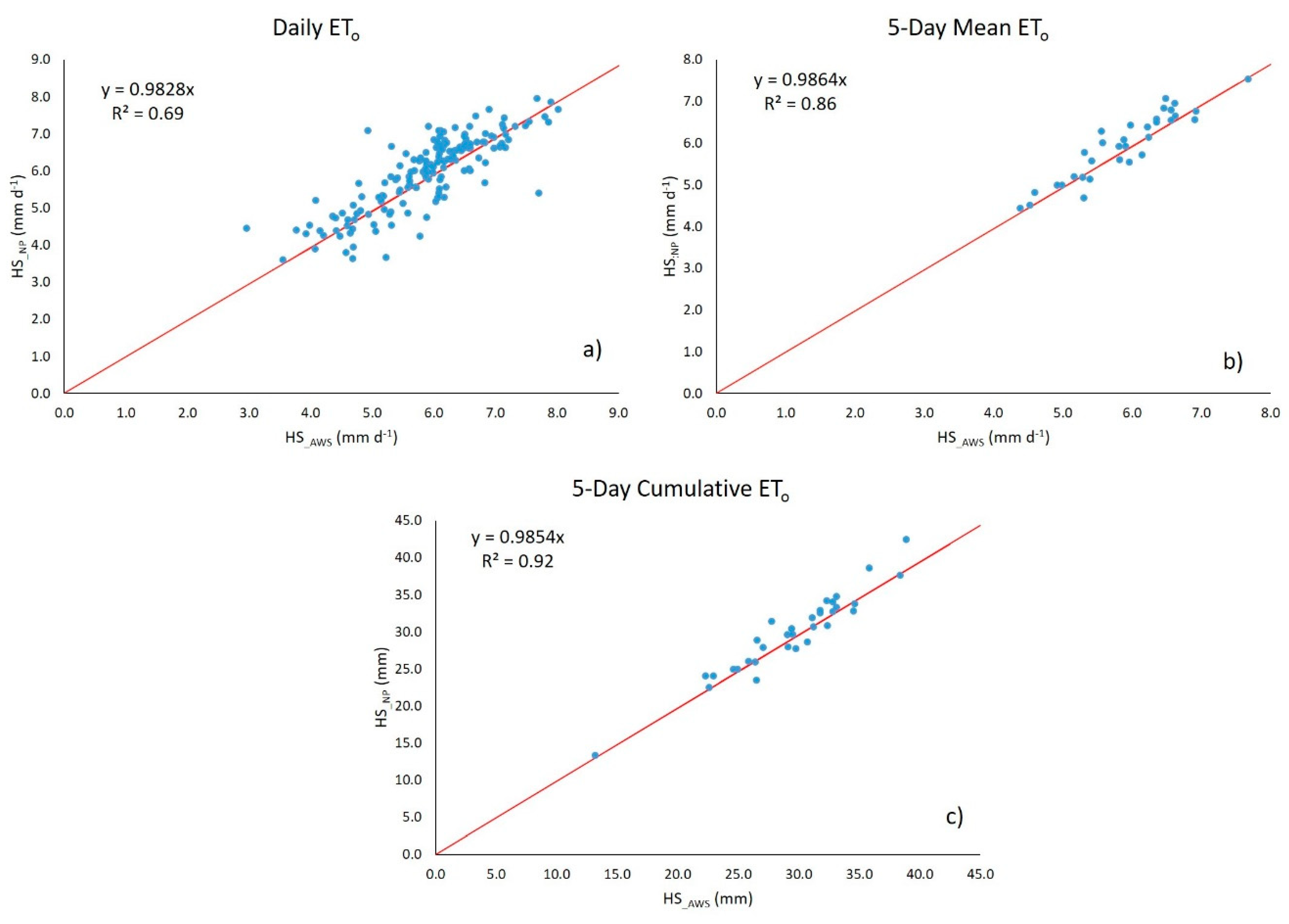1. Introduction
Reference evapotranspiration (ET
0) is the evapotranspiration rate of a hypothetical reference crop (grass or alfalfa) with a height of 0.12 m, a fixed surface resistance of 70 s m
-1, and an albedo of 0.23, homogeneous, well-watered, free from diseases and pests, growing vigorously, and providing complete shade to the soil [
1,
2,
3]. ET
0 measures atmospheric evaporation demand regardless of crop type, development, and management practices [
4,
5]. This variable is affected only by climatic factors [
6] and can be calculated from meteorological data [
2].
Estimating ET
0 is the first step in the design, planning, and management of different irrigation systems [
7,
8]. In addition, it is relevant for calculating crop water requirements [
9,
10]. This parameter is the backbone of the agronomic design of any irrigation system, facilitates its operation (irrigation schedule and shifts), and allows planning water resource management, either in a basin [
11] or in an irrigation district. Therefore, its accurate estimation is an essential step in water management, particularly in arid and semi-arid areas where water is scarce [
12].
Given the temporal and spatial variability of the climate, several methods to estimate ET
0 have been proposed, mainly empirical equations developed from field experiments and those based on theoretical approaches [
11]. These methods include the evaporimeter tank and empirical equations, including the complete physical model (FAO-56 Penman-Monteith), the equation based on temperature (Blaney-Criddle, Thornthwaite, and Turc), and the one based on temperature and radiation (Hargreaves, Jensen-Haise, Priestley-Taylor, and FAO Radiation), among others [
13].
The UN Food and Agriculture Organization (FAO) recommends the Penman-Monteith standard method described in the FAO-56 Manual because it can be used in arid, temperate, and tropical areas [
14]. However, this method requires various meteorological input variables (temperature, solar radiation, relative humidity, and wind speed), which restrains its widespread use [
15]. Therefore, its usefulness is limited in regions with no meteorological stations or shortage of input data [
16], which are usually not available with the frequency and quality required [
17]. The other equations can be used in regions with very little climatological information; such is the case of Hargreaves-Samani (HS) and Blaney-Criddle (BC) equations, which are the most common ones [
18,
19,
20] and only require temperature as an input variable [
21].
The accuracy of the HS and BC equations has been evaluated by several authors, comparing their results with the FAO-56 Penman-Monteith (PM) reference method; HS was the equation that attained the best fit in semi-arid regions [
22,
23]. Other authors state that the HS method works well in most climatic regions, except for wet areas where it tends to overestimate ET
0 [
8,
24,
25,
26]. Since HS was developed empirically based on data from arid to subhumid environments, it may not fit well to conditions markedly different from those considered for its calibration, as is the case of wet climates [
8]. On the other hand, the HS method underestimates ET
0 for dry and windy areas because it does not include wind, and is seemingly more accurate when applied for 5- to 7-day averages than for daily time scales [
27,
28]. However, despite a fairly good performance of the HS equation in most applications, particularly irrigation planning, several authors have attempted to either recalibrate the HS coefficients or parameters [
26,
29] or modify the equation itself [
30,
31] aiming to improve its performance.
Given the scarcity of climatological data for some regions, there is also the possibility to estimate ET
0 using gridded meteorological or reanalysis data [
32,
33,
34]; these can be obtained from the following platforms: National Aeronautics and Space Administration - Prediction Of Worldwide Energy Resource (NASA-POWER) [
17,
35], Global Land Data Assimilation System (GLDAS) [
36], Climate Forecast System ver. 2 (CFSv2) [
37], North American Land Data Assimilation System (NLDAS) [
38], and National Digital Forecast Database (NDFD) [
39]. Some of these systems are global and others regional; the latter provides data at a finer spatio-temporal resolution [
17], although this does not necessarily translate into high precision [
40]. Currently, NASA-POWER is one of the most used platforms for estimating this variable [
41,
42,
43]. The platform is free and easily accessible; it provides daily information on near-surface air temperature, precipitation, relative humidity, radiation, and wind direction and speed. In addition, data on these variables are arranged according to three different conditions: (1) “single point” with available time-series data based on geographic coordinates recorded and selected by the user; (2) “regional endpoint” that produces a time-series dataset for cells delimited by geographic coordinates selected by the user; and (3) “global endpoint” that produces long-term climatological averages at a global scale [
44]. However, such NASA-POWER climate information requires evaluation and validation with data from
in-situ weather stations for the area of interest [
35].
This study aims to compare the accuracy of ET0 calculated with the BC and HS methods relative to the FAO-56 Penman–Monteith (PM) reference method, with data recorded by an automated weather station (AWS) and using the NASA-POWER (NP) platform, for different calculation periods.
3. Results and Discussion
The daily ET
0 calculated by the PM method and with AWS meteorological data (
Figure 2) had the peak value (8.8 mm d
-1) on Julian day 126 (06 May 2021); on the same day, a wind speed of 5.0 m s
-1 was recorded, which was higher than the average recorded over the study period (2.2 m s
-1). On the other hand, the minimum ET
0 (2.2 mm day
-1) was recorded on Julian day 192 (11 July 2021) — the day that recorded a solar radiation value of 107.0 W m
-2, lower than the average for the study period (282.8 W m
-2). This low radiation was due to atypical conditions: high cloudiness (rainfall of 7.6 mm recorded) and high relative humidity (84.5 %). Some authors mention that wind speed and solar radiation are the climatic variables with the greatest influence on ET
0 estimates in the study area [
17]. Other authors reach the same conclusion when performing a sensitivity analysis in other regions [
56,
57,
58].
3.1. Comparison of ET0 estimated by Empirical Equations versus the Reference Method
Table 4 shows monthly and total ET
0 estimated using the empirical equations and the reference method (PM). Considering the month with the maximum ET
0 (May, with the HS and PM_NP equations and June with the BC method) and the reference method (PM), HS yielded an ET
0 value that was 6.6 % lower vs. PM; BC, 12.5 % lower; and PM_NP, 13.2 % higher. However, taking into account the month with the minimum ET
0 (February) and the PM method, HS yielded an ET
0 12.8 % higher vs. PM; BC, 6.8 % higher; and PM_NP, 14.2 % higher. It is observed that HS and BC underestimate ET
0 over most of the study period, consistent with the findings reported by some authors for an agroclimatic region similar to the study area [
59].
However, when considering total ET
0 (whole study period) and the PM method, HS recorded an ET
0 value 5.5 % lower vs. PM; BC, a value 15.6 % lower; and PM_NP, 10.6 % higher; therefore, HS was the equation that yielded values closest to the PM method. This is because HS considers temperature and radiation as the main energy sources that promote evapotranspiration [
1,
16].
The results in
Table 4 indicate an overestimation of ET
0 relative to the value obtained with the PM_NP method during the study period. The magnitude of this overestimation is related to the accuracy of each variable and has been reported only when using NP (NASA-POWER) data and the PM method [
42,
43,
60].
Table 5 summarizes the relationship between the climatic variables recorded by the AWS and those obtained from the NP platform during the study period, where wind speed (WS) and solar radiation (SR) showed a low and moderate relationship, respectively. This same behavior has been reported by some authors for WS [
17,
35,
61] and SR [
62]. By contrast, Tmax and RH recorded a high ratio, and Tmin, a very high ratio. Some authors reported similar
R2 values for Tmin and Tmax [
46] and RH [
17] to those obtained in the present study. WS was the variable that yielded the lowest
R2. This highlights the multiple challenges in determining this variable; these include quality control of the measured data, since improving this aspect may return more accurate estimates [
63].
Figure 3 depicts the bias in the data recorded by the automated weather station (AWS) relative to NP platform data for the following meteorological variables: temperature (maximum and minimum), relative humidity, solar radiation, and wind speed. It is observed that 44 % of the maximum temperature data evaluated (
n = 165) were virtually unbiased, while 39 % of NP data overestimated Tmax by 2.1 °C to 7.5 °C, and the rest of the data (17 %) underestimated Tmax by 1.2 °C to 5.5 °C (
Figure 3a). Regarding the minimum temperature, 39 % of the data evaluated showed bias values close to zero, while 46 % of the NP data overestimated Tmin by 1.6 °C to 5.1 °C and the rest (15 %) underestimated Tmin by 1.8 ºC to 5.3 °C (
Figure 3b).
The less biased RH values (values close to zero) were observed in 16 % of the evaluated data; the NP platform underestimated RH by 3.0 % to 38.8 % in 76 % of the data, and the rest of the data (7 %) overestimated RH by 5.9 % to 14.9 % (
Figure 3c). On the other hand, 45 % of the evaluated data showed the minimum differences in solar radiation bias (values between 0 MJ m
-2 d
-1 and 1.5 MJ m
-2 d
-1), while 36 % of the data overestimated radiation by 3.7 MJ m
-2 d
-1 to 17.2 MJ m
-2 d
-1, and the rest of the data (19 %) underestimated radiation by 2.9 MJ m
-2 d
-1 to 9.7 MJ m
-2 d
-1 (
Figure 3d).
Finally, 50 % of the WS data showed bias values close to zero. It is also observed that most data (41 %) overestimated WS by 1.4 m s
-1 to 2.9 m s
-1, and the rest of the data (9 %) underestimated WS by 1.2 m s
-1 to 3.3 m s
-1 (
Figure 3e).
Based on the above, the NP platform tends to overestimate Tmax, Tmin, SR, and WS, while it underestimates RH. This same behavior was reported by Jiménez et al. [
17] in the study area for Tmin, WS, and RH [
17].
Estimating the 5-day cumulative ET
0 improved the values of
R2,
r, and
c relative to daily ET
0 and 5-day mean ET
0. This behavior is consistent with the one reported by Jiménez et al. [
17], who obtained better
R2 and RMSE values when estimating 10-day mean ET
0 versus daily data. Also, this way of estimating ET
0 yielded reliability coefficients (
c) rated as “very good” for BC and PM_NP, and “good” for HS. However, PM_NP showed the best
R2,
r, and
c values, while HS yielded the best RMSE, PE, MBE, and b (
Table 6). The latter parameter returned values close to 1, indicating that the estimated values are statistically similar to observed or reference values [
8]. Some authors reported similar RMSE values (1.1 mm d
-1) when comparing ET
0 estimated by the HS equation and the PM method on a daily basis [
59,
64]. However, some authors recorded an RMSE (0.7 mm d
-1) for 10-day mean data, which is similar to the RMSE value obtained in the present study for 5-day cumulative ET
0 [
17].
When graphically comparing the empirical equations versus the reference method (PM), daily ET
0 and 5-day mean ET
0 show a greater variability (
Figure 4a and
Figure 4b); the 5-day cumulative ET
0 returned the best fit, with a lower variability of ET
0 values between the empirical equations and the PM method (
Figure 4c).
In addition, HS yielded a better fit than the reference method (PM) in the three ways of estimating ET
0. Other authors have also reported a better fit with the HS equation relative to other methods and taking PM as a reference for arid and semi-arid regions [
8,
25,
64]. This equation underestimates ET
0 over most of the study period because the methods based on solar temperature and radiation do not include wind speed [
11].
3.2. Comparison of estimated ET0 with observed (AWS) versus estimated (NP) data
Table 7 shows the results of the goodness-of-fit tests between ET
0 calculated by PM and the HS and BC methods using maximum and minimum temperature data from the NP platform for the different calculation periods (daily, 5-day mean, and 5-day cumulative). The analyses of variance, with a 95% confidence interval (
p-value <0.0001), indicate a significant linear relationship between the PM method and the HS
_NP and BC
_NP equations for the three calculation periods. HS
_NP yielded the best values of inferential parameters versus BC
_NP, except for
R2 and
r, in the daily ET
0 estimate. This indicates that HS with NP temperature data is a suitable option for estimating ET
0 for different periods. Besides, we found that the estimation percent error (PE) is lower than 5% with HS
_NP for the three ET
0 calculation periods. In addition, MBE is negative in the three periods, pointing to an underestimation with the HS
_NP method. Some authors report this same ET
0 underestimation effect in semi-arid regions during the winter-summer period [
17,
59].
The 5-day mean ET
0 estimate recorded the best values in most statistical parameters relative to the mean daily ET
0. However, the 5-day cumulative ET
0 estimate recorded the best
r and
R2 values compared with the other two estimates (daily ET
o and 5-day mean ET
o). These good results are obtained because grouping ET
0 over five days mitigates the variation in daily temperature associated with precipitation, wind speed, and cloudiness [
65].
Figure 5 shows the dispersion of the calibrated HS method (HS
_cal) relative to PM for the different ET
0 calculation periods, depicting the best data fit obtained using data accumulated over five days.
The comparison of ET
0 estimates with the HS equation using temperature data recorded by the AWS (HS
AWS) and from the NP platform (HS
NP) yielded a high correlation for daily ET
0 (
Figure 6a) and very high for the other two estimates (
Figure 6b and
Figure 6c); The 5-day cumulative ET
0 recorded the highest
R2. These
R2 values indicate the feasibility of estimating ET
0 using temperature data from the NP platform and using the HS formula [
17,
59,
64].
The accuracy of ET0 calculated with methods BC and HS was compared versus the FAO-56 Penman–Monteith (PM) reference method using data from an automated weather station (AWS) and the NASA-POWER platform (NP). In this comparison, the HS equation returned the best fit in the different ways of estimating ET0: daily, 5-day mean, and 5-day cumulative, with the latter yielding the best fit. In addition, temperature data (maximum and minimum) from the NP platform were suitable for estimating ET0 with the HS equation.
The above results showed that NP data are suitable for cumulative ET
0; therefore, NP is a reliable data source for programming medium- and low-frequency irrigation (sprinkler and surface irrigation), which are common in the study area. In addition, they provide spatially comprehensive data, unlike the point values recorded by weather stations [
66]. The latter is an enormous advantage when studying large areas, such as irrigation districts, in addition to being freely accessible.
Contributions of Authors
Conceptualization, M.A.B.-G. and G.D.-R.; methodology, M.A.B.-G., G.D.-R., and A.Q.-N.; formal analysis, M.A.B.-G., and G.D.-R.; research, M.A.B.-G., G.D.-R., and A.L.-P.; preparation of the original draft, G.D.-R.; writing, review, and editing, M.A.B.-G., A.Q.-N., A.L.-P., and J.E.-A.; supervision, M.A.B.-G. All authors have read and agree with the final manuscript version for publication.
